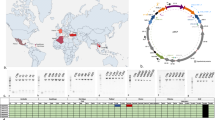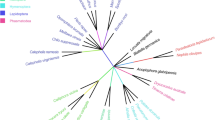Abstract
Pegasus, a novel transposable element, was discovered as a length polymorphism in the white gene of Anopheles gambiae. Sequence analysis revealed that this 535 bp element was flanked by 8 bp target site duplications and 8 bp perfect terminal inverted repeats similar to those found in many members of the Tcl family. Its small size and lack of long open reading frames preclude protein coding capacity. Southern analysis and in situ hybridization to polytene chromosomes demonstrated that Pegasus occurs in approximately 30 copies in the genomes of An. gambiae and its sibling species and is homogenous in structure but polymorphic in chromosomal location. Characterization of five additional elements by sequencing revealed nucleotide identities of 95% to 99%. Of 30 Pegasus-containing phage clones examined by PCR, only one contained an element exceeding 535 bp in length, due to the insertion of another transposable element-like sequence. Thus, the majority, if not all, extant Pegasus elements may be defective copies of a complete element whose contemporary existence in An. gambiae is uncertain. No Pegasus-hybridizing sequences were detected in nine other anophelines and three culicines examined, suggesting a very limited taxonomic distribution.
Similar content being viewed by others
References
Altschul S.F., W. Gish, W. Miller, E.W. Myers & D.J. Lipman, 1990. Basic local alignment search tool. J. Mol. Biol. 215: 403–410.
Atkinson P.W., W.D. Warren & D.A. O'Brochta, 1993. The hobo transposable element of Drosophila can be cross-mobilized in houseflies and excises like the Ac element of maize. Proc. Natl. Acad. Sci. U.S.A. 90: 9693–9697.
Besansky N.J., 1990. A retrotransposable element from the mosquito Anopheles gambiae. Mol. Cell. Biol. 10: 863–871.
Besansky N.J., 1993. Codon usage patterns in chromosomal and retrotransposon genes of the mosquito Anopheles gambiae. Insect Mol. Biol. 1: 171–178.
Besansky N.J. & J.R. Powell, 1992. Reassociation kinetics of Anopheles gambiae (Diptera: Culicidae) DNA. J. Med. Entomol. 29: 125–128.
Besansky N.J., S.M. Paskewitz, D. Mills Hamm & F.H. Collins, 1992. Distinct families of site-specific retrotransposons occupy identical positions in the rRNA genes of Anopheles gambiae. Mol. Cell Biol. 12: 5102–5110.
Besansky N.J., J.A. Bedell & O. Mukabayire, 1994. Q: a new retrotransposon from the mosquito Anopheles gambiae. Insect Mol. Biol. 3: 49–56.
Besansky N.J., J.R. Powell, A. Caccone, D. Mills Hamm, J.A. Scott, & F.H. Collins, 1994. Molecular phylogeny of the Anopheles gambiae complex suggests genetic introgression between principal malaria vectors. Proc. Natl. Acad. Sci. USA 91: 6885–6888.
Besansky N.J., J.A. Bedell, M.Q. Benedict, O. Mukabayire, D. Hilfiker & F.H. Collins, 1995. Cloning and characterization of the white gene from Anopheles gambiae. Insect Mol. Biol. 4: 217–232.
Black D.M., Jackson M.S., Kidwell M.G. & G.A. Dover, 1987. DP elements repress P-induced hybrid dysgenesis in Drosophila melanogaster. EMBO J. 6: 4125–4135.
Black W.C. & K.S. Rai, 1988. Genome evolution in mosquitoes: intraspecific and interspecific variation in repetitive DNA amounts and organization. Genet. Res., Camb. 51: 185–196.
Brown J.J., M.G. Mattes, C. O'Reilly & N.S. Shepherd, 1989. Molecular characterization of rDt, a maize transposon of the “Dotted” controlling system. Mol. Gen. Genet. 215: 239–244.
Bureau T.E. & S.R. Wessler, 1992. Tourist: a large family of small inverted repeat elements frequently associated with maize genes. The Plant Cell 4: 1283–1294.
Bureau T.E. & S.R. Wessler, 1994. Stowaway: a new family of inverted repeat elements associated with the genes of both monocotyledonous and dicotyledonous plants. The Plant Cell 6: 907–916.
Collins F.H., M.A. Mendez, M.O. Rasmussen, P.C. Mehaffey, N.J. Besansky & V. Finnerty, 1987. A ribosomal RNA gene probe differentiates member species of the Anopheles gambiae complex. Am. J. Trop. Med. Hyg. 37: 37–41.
Coluzzi M., A. Sabatini, V. Petrarca, & M.A. DiDeco, 1979. Chromosomal differentiation and adaptation to human environment in the Anopheles gambiae complex. Trans. Roy. Soc. Trop. Med. Hyg. 73: 483–497.
Crain W.R., F.C. Eden, W.R. Pearson, E.H. Davidson & R.J. Britten, 1976. Absence of short period interspersion of repetitive and non-repetitive sequences in the DNA of Drosophila melanogaster. Chromosoma 56: 309–326.
Daniels S.B., S.H. Clark, M.G. Kidwell & A. Chovnick, 1987. Genetic transformation with an autonomous P element: phenotypic and molecular analysis of long-established transformed lines. Genetics 115: 711–723.
Elizur A., A.T. Vacek & A.J. Howells, 1990. Cloning and characterization of the white and topaz eye color genes from the sheep blowfly Lucilia cuprina. J. Mol. Evol. 30: 347–358.
Genetics Computer Group, 1994. Program Manual for the Wisconsin Package, Version 8. 575 Science Dr., Madison, WI 53711 USA.
Hartl D.L., E.R. Lozovskaya, & J.G. Lawrence, 1992. Nonautonomous transposable elements in prokaryotes and eukaryotes. Genetica 86: 47–53.
Henikoff S., 1992. Detection of Caenorhabditis transposon homologs in diverse organisms. New Biol. 4: 382–388.
Higgins C.F., 1992. ABC transporters: from microorganisms to man. Annu. Rev. Cell Biol. 8: 67–113.
Hsia A. & P.S. Schnable, 1996. DNA sequence analyses support the role of interrupted gap repair in the origin of internal deletions of the maize transposon, MuDR. Genetics 142: 603–618.
Kumar V. & F.H. Collins, 1994. A technique for nucleic acid in situ hybridization to polytene chromosomes of mosquitoes in the Anopheles gambiae complex. Insect Mol. Biol. 3: 41–47.
Merriman P.J., C.D. Grimes, J. Ambroziak, D.A. Hackett, P. Skinner, & M.J. Simmons, 1995. S elements: a family of Tcl-like transposons in the genome of Drosophila melanogaster. Genetics 141: 1425–1438.
Mukabayire, O. & N.J. Besansky, 1996. Distribution of T1, Q, Pegasus and mariner transposable elements on the polytene chromosomes of PEST, a standard strain of Anopheles gambiae. Chromosoma, in press.
Periquet G., M.H. Hamelin, Y. Bigot, & K. Hu, 1989. Presence of the deleted hobo element Th in Eurasian populations of Drosophila melanogaster. Genet. Sel. Evol. 21: 107–111.
Robertson H.M., 1993. The mariner transposable element is wide-spread in insects. Nature 362: 241–245.
Robertson H.M. & D.J. Lampe, 1995. The distribution of transposable elements in arthropods. Annu. Rev. Entomol. 40: 333–357.
Salazar C.E., D. Mills Hamm, D.M. Wesson, C.B. Beard, V.K. Kumar & F.H. Collins, 1994. A cytoskeletal actin gene in the mosquito Anopheles gambiae. Insect Mol. Biol. 3: 1–13.
Sharp P.M. & W.-H. Li, 1989. On the rate of DNA sequence evolution in Drosophila. J. Mol. Evol. 28: 398–402.
Warren W.D., P.W. Atkinson & D.A. O'Brochta, 1994. The Hermes transposable element from the house fly, Musca domestica, is a short inverted repeat-type element of the hobo, Ac, and Tam3 (hAT) element family. Genet. Res. Camb. 64: 87–97.
Zwiebel L.J., G. Saccone, A. Zacharopoulou, N.J. Besansky, G. Favia, F.H. Collins, C. Louis & F.C. Kafatos, 1995. The white gene of Ceratitis capitata: a phenotypic marker for germline transformation. Science 270: 2005–2008.
Author information
Authors and Affiliations
Rights and permissions
About this article
Cite this article
Besansky, N.J., Mukabayire, O., Bedell, J.A. et al. Pegasus, a small terminal inverted repeat transposable element found in the white gene of Anopheles gambiae . Genetica 98, 119–129 (1996). https://doi.org/10.1007/BF00121360
Received:
Accepted:
Issue Date:
DOI: https://doi.org/10.1007/BF00121360




